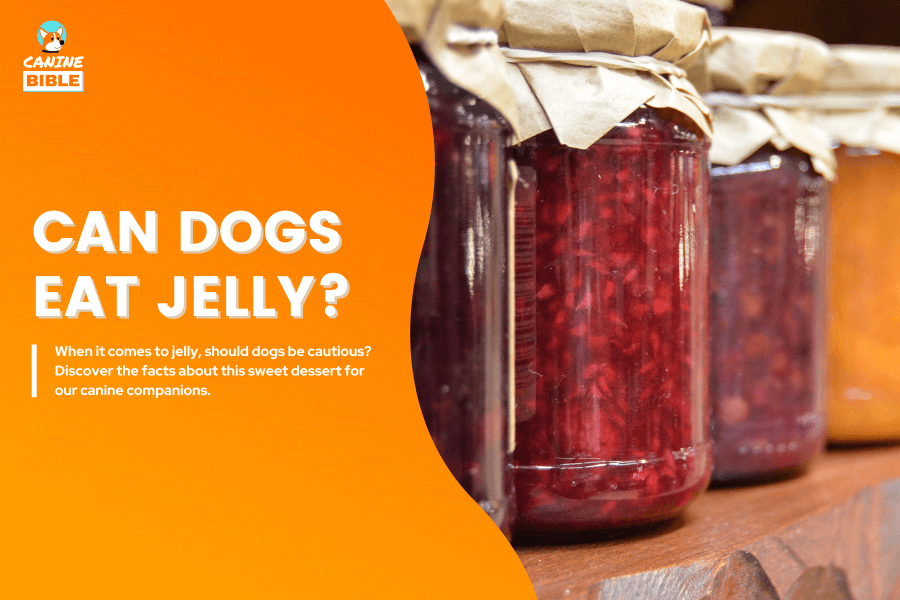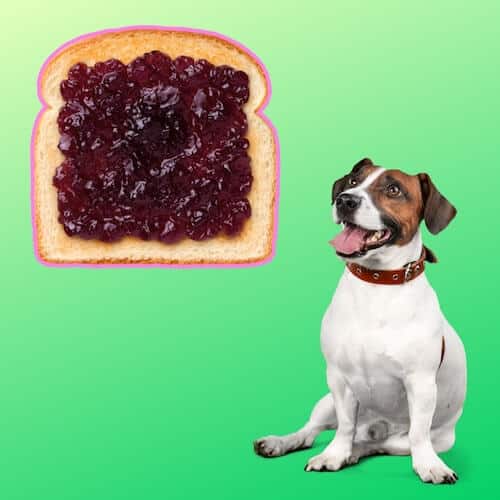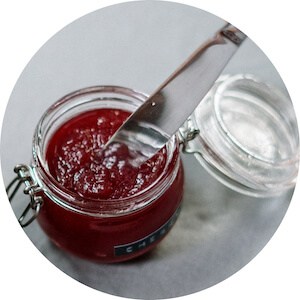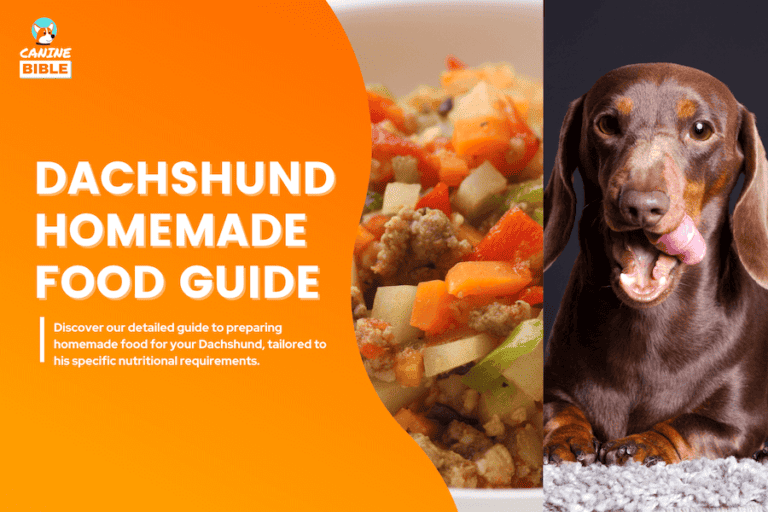Can Dogs Eat Jelly? Is It Bad or Good For Dogs?

Canine Bible is reader-supported. We receive affiliate commissions via some of our links. This doesn’t affect rankings. Learn more.
A question that often puzzles many dog owners is, “Can dogs eat jelly?” This sweet, spreadable substance is a staple in many households, but does it belong in a dog’s diet? In this comprehensive guide, we will explore the implications of feeding jelly to your dog, dissecting the myths and facts to understand what’s best for your pet’s health.

What Is Jelly: Jelly, a popular spread in many households, is a clear or translucent fruit spread made by extracting fruit juice (whole fruits) and cooking it with sugar and pectin (natural or commercially produced). Pectin is a naturally occurring soluble polysaccharide found in fruits that thickens jelly to a firm but gives it a spreadable consistency.[1] Unlike jam, which contains fruit pieces, jelly is made only from the juice of the fruit, resulting in a smoother consistency.
Is Jelly Good For Dogs?
Jelly is not good for dogs. The high sugar content in most jellies can cause concern, especially for dogs with weight issues or diabetes. Jelly is a high-sugar product comprised of about 48–54% sugar.[2] Each tablespoon of jelly contains about 1 to 2 teaspoons of sugar. That’s a lot of sugar for your dog. Consuming too much sugar may lead to various health problems in dogs. Additionally, some jellies contain artificial sweeteners like xylitol, which is toxic to dogs, or high levels of preservatives and artificial colors, which can be harmful in long-term consumption.
Jelly Components Toxicity Analysis In Dogs
Is Jelly Toxic For Dogs?
While some jelly components are not inherently dangerous to dogs, the high sugar content and the potential presence of harmful artificial sweeteners like xylitol make it an unsuitable and potentially dangerous treat for dogs. It’s always best to err on the side of caution and choose dog-specific treats formulated to be safe and healthy for them.
Can Dogs Have Jelly?
No, dogs should not be fed jelly. Jelly is mostly sugar, and its high sugar content contains no nutritional value for dogs. Ingesting excessive amounts of (sugar) jellies can cause inflammation throughout the body, leading to issues such as obesity, dental problems, and, in severe cases, diabetes.

4 out of 8 components in jelly
are not safe for dogs
Is Jelly Healthy For Dogs?
Jelly is not considered a healthy treat for dogs. The nutritional content of jelly typically includes a high percentage of simple carbohydrates, primarily from sugars. While it provides a quick energy source, it lacks essential nutrients like protein, fiber, and healthy fats, which are crucial for a balanced canine diet. Some jellies may contain small amounts of Vitamin C and specific B vitamins, but these are usually not significant enough to contribute positively to a dog’s nutrition or health. The fruit in jellies is heated to high temperatures, further reducing their nutritional properties.
Is Jelly Bad For Dogs?
Yes, if fed in large quantities, jelly can be bad for dogs. It contains artificial sweeteners like xylitol or is made with toxic fruits or other toxic ingredients. It’s recommended you store jelly in a place inaccessible to dogs.
Possible Side Effects & Risks of Jelly In Dogs
The following symptoms may indicate a bad reaction to jelly.
Prolonged exposure to sugary foods like jelly may result in diabetes, pancreatitis, cavities, and obesity.
What Should I Do If My Dog Ate Jelly?
One or two bites of jelly shouldn’t cause too much concern. Immediately remove any remaining Jelly from your dog’s mouth, rinse their mouth thoroughly, and provide plenty of water. It’s crucial to prevent your dog from eating Jelly again. Monitor your dog for the next 24-48 hours, as some reactions can be delayed.
Call your veterinarian if your dog has consumed a large amount of jelly or if the jelly contains xylitol, grape, or any other dog-toxic ingredients and is experiencing any of the symptoms listed above.
Can’t reach your vet? Contact the Pet Poison Helpline at 1-855-764-7661 or chat live with a veterinary professional via our online vet chat or video chat support (24 hours a day, 7 days a week).
Dogs showing worsening symptoms, such as blood in their vomit or stool, difficulty breathing, weakness, or collapse, should be taken to the veterinarian immediately.
Are Dogs Allergic to Jelly?
While not common, some dogs may have an allergic reaction to jelly. Symptoms of an allergic reaction can include itching, swelling, hives, and, in severe cases, anaphylaxis, which is a medical emergency.
If you suspect your dog is having an allergic reaction to any food, including jelly, it is crucial to consult a veterinarian. Your vet can provide appropriate advice and help you formulate a safe diet plan for your dog. We also recommend conducting an at-home dog allergy test to determine if your dog is sensitive or intolerant to certain foods.
Can Puppies Eat Jelly?
No, puppies should not eat jelly. Their digestive systems are more sensitive than those of adult dogs, making them more susceptible to the side effects of jelly, which could lead to more severe reactions.
It’s important to prioritize a well-balanced diet for puppies suitable for their age, size, and breed. This diet should mainly consist of high-quality puppy food and treats specifically formulated to support their growth and development. Introducing human foods, particularly those spicy or highly sugary like jelly, should be avoided to safeguard their health and well-being.
Safer Alternatives to Jelly For Dogs
Here’s a list of jelly alternatives that are both safe and nutritious.
Frequently Ask Questions
Are Dogs Allowed Jelly? — Conclusion
No. Jelly shouldn’t be allowed near dogs. While jelly may be a tempting treat to share with your furry friend, it’s important to understand the risks it poses to their health. Feeding this sugary treat only calls for trouble.
As responsible pet owners, it’s crucial to prioritize the health and well-being of our dogs by being mindful of their diet. Treats given to dogs should be appropriate for their dietary needs and not pose health risks. It’s always better to choose dog-specific treats formulated for their health and nutritional requirements.
We encourage you to consult with your veterinarian before introducing new foods into your dog’s diet. They can provide personalized advice based on your dog’s health, breed, and dietary needs. Remember, what is safe for humans isn’t always safe for dogs.
Like It? Subscribe & Share!
Sources
Canine Bible uses only high-quality sources, including peer-reviewed studies, to support the facts within our articles. Read our editorial process and product review methodology to learn more about how we fact-check, test products, and keep our content accurate, reliable, and trustworthy.
Canine Bible authorship represents the unified voice of our entire editorial team and our in-house veterinarians rather than a single author. Each article, blog post, and review published under the Canine Bible name undergoes a rigorous review process, involving all team members to guarantee accuracy and up-to-date in accordance with the latest veterinarian research. This collaborative effort is an integral part of our editorial process and aligns with our four pillars of content creation. This approach ensures our content is backed by expert knowledge and factual information, offering our readers reliable, actionable, and trustworthy content.



![Dalmatian Homemade Dog Food Diet & Recipes [Guide]](https://www.caninebible.com/wp-content/uploads/2023/08/Dalmatian-Homemade-Dog-Food-1-768x512.png)




